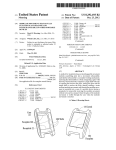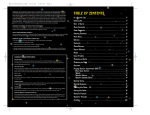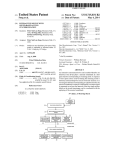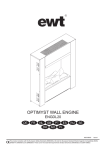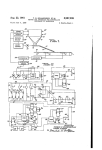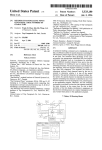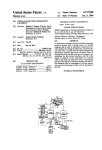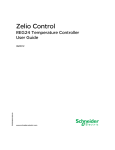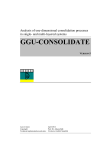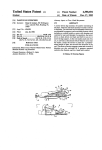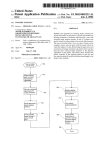Download Acoustic triggered laser device for simulating firearms
Transcript
lllllllllllllllllllllllllllllllll||||l||l|l||||l|||llllllllllllllllllllllll US005605461A United States Patent 1191 [11] Patent Number: Seeton [45] [54] 5,605,461 Date of Patent: Feb. 25, 1997 ACOUSTIC TRIGGERED LASER DEVICE 5,119,576 6/1992 Erming . FOR SMULATING FIREARMS 5,194,007 5,237,773 3/1993 Marshall et a1. ........................ .. 434/21 8/1993 Claridge . Inventor: Gary Station,E-Tex. Seetoll, 77840 FiI'CSidC, College [21] Appl. No.: 330,199 [22] Flled‘ - Beamhit I 10 User’s Manual, Beamhit Systems, pp. 1-47 (Ape 1994)- ' , Primary Examiner—Richard J. Apley Oct' 27’ 1994 Assistant Examiner—John Mulcahy [51] Int. Cl.6 ...................................................... .. F41G 3/26 Attorney, Agent, or Firm-Pravel, Hewitt, Kimball & [52] US. Cl. ......... .. Kl‘ieger [58] Field of Search ................................ .. 434/19, 21, 22; .. 434/21; 42/103 [57] ABSTRACT 381/155, 169, 173; 372/31, 38; 42/103 A device that simulates the ?ring of a ?rearm. The device [56] References Cited 3,526,972 9/1970 Sumpf_ includes a piezoelectric crystal for detecting high amplitude acoustic pulses generated when the ?ring mechanism of the ?rearm is activated. The piezoelectric crystal provides a voltage pulse to a amplitude detecting circuit. If the pulse 3,633,285 1/1972 Sensney . generated by the piezoelectric crystal is above a threshold Us" PATENT DOCUMENTS 3,938,262 2/1976 Dye et al. . 3,995,376 12/ 1976 Kimble 61 vi gkilahhem ~ value, the amplitude detecting circuit causes a laser diode to be energized. The laser diode directs a beam at the target to 4,313,272 4,313,273 2/1982 Matthews I 2/1982 Matthews et a1. _ allow the user to determine where the “shot” is ?red. The laser d1ode1s activated for a 'su?iciently long period of time to allow the laser spot to be v1s1ble to‘the human eye'and also 4,367,516 4,678,437 4,761,907 1,1983 Jacob _ 7/1987 Scott et a1. .............................. .. 434/21 g/19g8 De Bern-Mimi ' to allow a streak to be developed 1f the ?rearm is pulled Slightly by the user when the trigger is Phhed- The deviee is conveniently mounted under the barrel of the ?rearm. 4,830,617 5/1989 Hancox et al. . 4,947,859 8/1990 Brewer et a1. ........................ .. 381/169 , , aw I . . . . . 43 Claims, 4 Drawing Sheets A j . 20 . US. Patent Feb. 25, 1997 Sheet 1 of 4 5,605,461 U.S. Patent Feb. 25, 1997 Sheet 2 of 4 5,605,461 ‘1 A I I '| FZ/G. ) 5/ k57 US. Patent Feb. 25, 1997 Sheet 3 0f 4 5,605,461 5,605,461 1 2 quency of the acoustical energy generated by the ?ring ACOUSTIC TRIGGERED LASER DEVICE FOR SI1VIULATING FIREARMS mechanism of a gun shifts with changes in temperature. In addition, different ?rearms have different frequency charac teristics, which would require that the simulation device be modi?ed for di?erent ?rearms. Therefore, it is desired that a ?rearm simulation device be developed that is simple to use and that does not require BACKGROUND OF THE INVENTION 1. Field of the Invention The invention relates to an apparatus for simulating modi?cation to be used with different types of ?rearms. ?rearms, and more particularly, to a device for mounting on a ?rearm which utilizes a laser beam to simulate the ?ring of real ammunition. SUMMARY OF THE PRESENT INVENTION 2. Description of the Related Art The simulation device according to the present invention includes a means for sensing the acoustical energy devel Various marksmanship training devices that simulate the ?ring of a ?rearm have been developed. These devices allow oped by the hammer in a ?rearm falling on the ?ring pin. The sensing means is preferably a piezoelectric crystal. In a “dry” ?re situation, that is, no bullets are actually being ?red, the fall of the hammer on the ?ring pin delivers a the owner of a ?rearm, such as a handgun or a ri?e, to improve their shooting skills without the need for live ammunition. Certain devices, such as the one disclosed in U.S. Pat. No. 4,367,516, entitled “MARKSMANSHIP higher amplitude pulse then any other action that is likely to TRAINING DEVICE AND METHOD” by Jacob, require the disassembly of the ?rearm and replacement with tem befall a gun in normal practice. To sense this high amplitude porary parts to form a device that ?res a light beam upon activation of the trigger on the ?rearm. These devices are 20 generated by the ?ring mechanism, the piezoelectric crystal generally difficult to use and are limited to those persons who are familiar with the assembly and disassembly of ?rearms. In an alternative device, disclosed in U.S. Pat. No. 5,237,773, entitled “INTEGRAL LASER SIGHT, SWITCH FOR A GUN” by Claridge, a switch is mounted on the back of the gun handle so that it can be momentarily operated by the thumb of the trigger hand to emit a visible laser beam. However, this provides a poor simulation of real weapon operation, as manual operation of the switch requires the pulse, the piezoelectric crystal can be placed at any conve nient location on the ?rearm. In response to the pulse provides a high amplitude signal to a amplitude sensing circuit, which is designed to trigger at a su?‘iciently high 25 30 user to deviate from his or her normal grip of the ?rearm. In yet another device, described in U.S. Pat. No.3,938, 262 entitled “LASER WEAPON SIMULATOR” by Dye, et voltage so that any other signal source would be below the triggering threshold. If the amplitude sensing circuit pro vides a signal indicating that a su?iciently high input voltage has just been received, a light emitting device, which is preferably a laser diode, is turned on for a suf?ciently long period to allow a visible laser spot to be developed on the target. In addition, the laser diode stays on long enough to show a slight streak to indicate if the gun is being pulled to one side with the pulling of the trigger, which is a common mistake made during the ?ring of a weapon. Further, the a1., a piezoelectric crystal mounted on the gun is used to 35 device can be used as a replacement for tracer bullets to indicate where a bullet is being ?red. For use in tracer mode, sense shock waves produced by the ?ring of blank car an overvoltage circuit is included in the device to protect the tridges. In response to the generated shock waves, the device from the extremely high voltages generated by the piezoelectric crystal oscillates to provide electrical energy to piezoelectric crystal in response to the ?ring of an actual a laser diode, which emits an infrared output pulse. The infrared output pulse, which is invisible to the human eye, 40 bullet. One of the advantages of the device according to the present invention is that it can be conveniently mounted on strikes an infrared detector located on the target to indicate the outside of the ?rearm. Another advantage is that detec when a hit is scored. In a second embodiment of the device tion of the amplitude of the pulse generated by the ?ring described in Dye, the piezoelectric crystal is mounted within mechanism is simple to implement, as there are no other 45 mechanisms on the ?rearm or external stimuli during normal use of the ?rearm that would cause such a high amplitude in turn causes the piezoelectric crystal to provide power to the cartridge of the ri?e such that pulling the trigger causes the hammer of the ri?e to hit the piezoelectric crystal. This pulse. the laser diode for the emission of the infrared pulse. One disadvantage of the ?rst embodiment disclosed in Dye is that BRIEF DESCRIPTION OF THE DRAWINGS costly blank cartridges are required. A disadvantage of the second embodiment of the Dye device is that it is di?icult to mount a piezoelectric device into the cartridge of a ?rearm. The piezoelectric device must be mounted in a very speci?c A better understanding of the present invention can be location so that the hammer of the gun can make contact. Another device, disclosed in U.S. Pat. No. 3,633,285, entitled “LASER MARKSMANSHIP TRAINER” by Sen 55 sney, detects the acoustical energy generated by the impact of the hammer striking the ?ring pin when the trigger on the ?rearm is pulled. In this device, a piezoelectric crystal is also to the preferred embodiment of the present invention attached to a handgun; FIG. 1B is a diagram of an alternative embodiment of the simulation device; used to sense the acoustical vibrations. The electrical signals generated by the piezoelectric crystal in response to the obtained when the following detailed description of the preferred embodiment is considered in conjunction with the following drawings, in which: FIG. 1A is a diagram of the simulation device according 60 FIG. 2 is a diagram of a module in the simulation device of the signal that are not produced by the ?ring mechanism. of FIG. 1A containing a piezoelectric crystal and circuitry responsive to the piezoelectric crystal for powering a laser Sensney discloses either a high pass ?lter or a bandpass ?lter diode; vibrations are passed through a ?lter to remove components to select the desired frequency corresponding to the fre quency of the acoustical energy generated by the ?ring mechanism of a ?rearm. However, use of such a frequency discrimination device is dif?cult to implement, as the fre ' FIG. 3 is a schematic diagram of circuitry responsive to 65 acoustical energy generated by the activation of the ?ring mechanism of the handgun for powering a laser diode to emit a laser beam onto a target; and 5,605,461 3 4 FIG. 4 is a schematic diagram of the circuitry of FIG. 3 in which the on/off switch has been replaced by REED relay on the target 20. This streak lets the user know that he or she is ?ring the handgun improperly. Thus, use of the simulation device 12 allows a user to practice ?ring the handgun 10 without the need for real bullets. A further advantage is that circuitry. a user can practice ?ring the handgun 10 in the convenience DETAILED DESCRIPTION OF THE PREFERRED EMBODIMENT of his or her own home, without having to go to a practice ?ring range. Referring now to FIG. 1A, a simulation device 12 accord ing to the present invention is shown attached to a handgun 10. It is appreciated that the simulation device 12 can be used with other types of ?rearms, such as ri?es. In the The simulation device 12 can also be utilized as a replace ment for tracer bullets when used in conjunction with a 10 preferred embodiment, the attachment of the simulation device 12 to the handgun 10 is accomplished via a mounting bracket 13, which is attached with adhesives to the bottom of the barrel 22 of the handgun 10. The simulation device 12 includes a housing 40, which is slidably mounted onto the mounting bracket 13. Enclosed in the housing 40 of the simulation device 12 is a battery 46 and a cylindrical shaped module 44, which houses a piezoelectric crystal for detect loaded handgun 10. The laser beam generated by the simu lation device 12 upon the ?ring of the handgun 10 indicates where the bullet has been ?red. Preferably, a simulation device 12 for use in the tracer mode includes further means for adjusting the on time of the laser diode device 42, such that the laser spot can be observed by a person wearing night vision equipment. A handgun 10 used in tracer mode is adapted with a ?ash suppressor to eliminate the ?ash asso ciated with the ?ring of the handgun 10. 20 ing the acoustical pulse generated by the activation of the Refen‘ing now to FIG. 1B, an alternative embodiment is shown of the simulation device 12. In the alternative ?ring mechanism on the handgun 10. It is understood that other acoustic sensors, such as various other microphone embodiment, a shaft 26 has been provided for ?tting down the bore of the barrel 22 of the handgun 10. Clamps 28a and designs, can be used instead of the piezoelectric crystal. The ?ring mechanism includes a hammer 18 and a ?ring pin (not shown) located inside the handgun 10. When a trigger 16 is pulled, the hammer 18 rises and falls on the ?ring pin. This 28b are used to secure the simulation device 12 to the tip 24 25 causes acoustical energy to be generated in the frame of the ever, use of the simulation device 12 in this manner may handgun 10. The device 12 according to the present invention can also be used with a loaded handgun 10, such as when used in _ tracer mode. In this case, pulling the trigger 16 would ?re the weapon, which would generate much greater acoustical energy. As a result, overvoltage protection circuitry is energy generated by the ?ring of a bullet. In either case, however, the amplitude of the acoustical energy generated by the activation of the ?ring mechanism is much greater than any acoustical energy that could be caused by other stimuli during normal use of the handgun 10. The high amplitude pulse generated by the activation of detail. For clarity, the components shown in FIG. 2 are not drawn to scale. Enclosed in the casing 48 of the module 44 the ?ring mechanism moves in a direction generally parallel to the axis B—B' of the barrel 22 of the gun 10. The pulse generate an electrical pulse to activate a laser diode device 42, which emits a beam directed at a target 20. The laser are a circuit board 54, the laser diode device 42 and a 45 beam is directed through a lens 11 in the housing 40. An on/off switch 30 is provided on the external surface of piezoelectric crystal 58. The laser diode device 42 is elec trically connected to the circuit board 54 by electrical wires 62. Circuitry for responding to the piezoelectric crystal 58 and for activating the laser diode device 42 are implemented on the upper surface 60 of the circuit board 54. For better clarity, the details of how the circuit board 54 and the laser diode device 42 are mounted inside the casing 48 of the the housing 40 to allow the user to disable the simulation device 12. In addition, a switch 32 is provided to allow the user to manually turn on the laser diode device 42 for aiming module 44 are not shown, as those details are readily the handgun 10. Preferably, the manual switch 32 is located on the handle 21 of the handgun 10 for convenient access by the user. The switch 32 is connected to the simulation device 55 12 via an electrical wire 31. In an alternative embodiment, the on/off switch 30 can be removed, replaced with a plug in line with the manual switch 32. The plug is connected to the module 44 in such a manner that reversing its connection allows the manual switch 32 to act as an on/off switch. 60 Removal of the on/oif switch 30 allows for further space savings. The laser diode device 42 is preferably activated for a few milliseconds in response to the trigger 16 being pulled to allow a visible spot to be temporarily generated on the target 20. If the handgun 10 is pulled slightly to a side when the trigger 16 is being pulled by the user, a streak is developed present a safety hazard if the user is not careful, since ?ring a live bullet with the device 12 ?tted down the bore of the barrel 22 will cause the handgun 10 to explode. In yet another embodiment, the simulation device 12 is encased in a housing shaped like a ?anged cartridge, which can be inserted from the rear of the barrel 22 by temporarily removing the weapon slide 14 of the handgun 10. This con?guration also allows the simulation device 12 to be used without permanently mounting it to the handgun 10, while ensuring that live bullets cannot accidentally be ?red. Referring now to FIG. 2, the module 44 containing the piezoelectric crystal and other circuitry is shown in greater included in the device 12 to protect it from the acoustical is sensed by the piezoelectric crystal element included in the module 44. In response, other circuitry in the module 44 of the barrel 22. The alternative embodiment allows the simulation device 12 to be more easily retro?tted to existing ?rearms without the need for permanent mounting. How 65 apparent to those skilled in the art. The module 44 is positioned such that its length runs along a line A—A'. The line A—A' is generally parallel to the axis B—B' of the barrel 22 of the handgun 10. The circuit board 54 is mounted inside the casing 48 of the module 44 such that the surface 60 of the circuit board 54 is also generally parallel to the line A—A'. A slot 56 is cut along the width of the circuit board 54 at one end. One edge 51 of a cantilever beam 52 is ?tted into the slot 56. The cantilever beam 52 protrudes from the bottom surface of the circuit board 54, and its front surface 57 is generally perpendicular to the bottom surface of the circuit board 54. The front surface 57 of the cantilever beam 52 is also generally perpendicular to the line A—A'. The piezoelectric crystal 58 is made from a material known as polyvinylidene ?uoride, which is ?exible in nature and is not 5,605,461 5 6 subject to fracture as are most other piezo materials. A thin wiper of a potentiometer 117, which has its ?xed resistor connected between the supply node V+ and the node T—. The output of the ampli?er 106 is connected to the base of ?lm of the piezoelectric crystal 58 is coated onto the front surface 57 of the cantilever beam 52, such that the surface of the piezoelectric crystal 58 is also generally perpendicular to the line A—A'. The piezoelectric crystal 58 is preferably an NPN transistor 118 through a resistor 120. The emitter of the transistor 118 is connected to node V— and its collector unidirectional; that is, it is more sensitive to acoustical is connected to a node M—. energy traveling along one direction and much less sensitive to acoustical energy traveling in a perpendicular direction. Thus, in the preferred embodiment, the piezoelectric crystal In operation, the steady state condition of the output of the ampli?er 106 is 0 volts. A positive voltage pulse is generated between nodes T+ and T— by the piezoelectric crystal 58 in 58 is more sensitive to acoustical energy traveling in a response to acoustical energy, such as that generated by the direction generally parallel to line A—A' and much less sensitive to acoustical energy traveling in a direction gen erally perpendicular to the line A-A'. As discussed above, shock waves generated by the ?ring mechanism of the handgun 10 travel in a direction generally parallel to the axis B—B' of the barrel 22. By positioning the 15 cantilever beam 52 such that its surface 57 is generally perpendicular to the direction of the acoustical energy pulse, and by using a unidirectional piezo element, the piezoelec tric crystal 58 is made more sensitive to acoustical energy generated by the ?ring mechanism. ?ring mechanism of the handgun 10. The piezoelectric crystal 58 may also generate a voltage pulse in response to other stimuli, which include the user bumping the handgun 10 with his or her hands. However, the voltage pulse generated by the piezoelectric crystal 58 in response to the latter stimuli is much smaller than the voltage pulse caused by the hammer 18 hitting the ?ring pin when the trigger 16 is pulled. Additionally, use of a unidirectional piezo element minimizes the sensitivity of the piezoelectric crystal 58 to acoustical energy not moving in a direction generally par allel to the line A—A'. The voltage pulse is provided to the non-inverting input of the ampli?er 106 through the capaci Additionally, the motion of the cantilever beam 52 causes the piezoelectric crystal 58 to be even more sensitive to tor 104, which ?lters out any DC voltage components on the acoustical energy traveling in a direction generally parallel input voltage. If the pulse is an excessively large voltage, to line A——-A'. The cantilever beam 52 is made of a resilient 25 such as that generated when an actual bullet is ?red, the material, and shock waves generated by the ?ring mecha varistor 103 protects the ampli?er 106 by limiting the nism of the gun causes the cantilever beam 52 to initially de?ect in the direction of the shock waves. Due to its magnitude of the voltage that can exist at the non-inverting resilient nature, the cantilever beam then swings back in the opposite direction to begin oscillating. After a short while, the oscillation of the cantilever beam 52 dies down. In response to the acoustical energy pulse, the piezoelec tric crystal 58 generates electrical pulses, which are routed to circuitry on the circuit board 54 via solder pads 50. this by shunting current from the node connected to the non-inverting input of the ampli?er 106 to node T—. Triggering circuitry and driver circuitry on the circuit board 54 then provides electrical signals through electrical wires 62 to activate the laser diode device 42, which responds by emitting a laser beam. Referring now to FIG. 3, a schematic diagram is shown of a trigger circuit 100 responsive to acoustical energy gener input of the ampli?er 106. The varistor 103 accomplishes If the voltage pulse provided to the non-inverting input is above a certain threshold voltage, then the ampli?er 106 drives its output to a positive voltage. The threshold voltage is determined by the potentiometer 117. By varying the 35 voltage value is variable to allow for ?exibility so that the threshold value can be adjusted if needed according to the type of gun and the environment of anticipated use. If the 40 ated in the handgun 10 and a driver circuit 101 for powering the laser diode 42, both of which are implemented on the circuit board 54. In response to the high amplitude acoustical energy generated by the hammer l8 falling on the ?ring pin when the trigger 16 is pulled, the piezoelectric crystal 58 wiper location of the potentiometer 117, the voltage at the inverting input of the ampli?er is varied. The threshold 45 input voltage pulse has a magnitude that is lower than the threshold voltage, which would usually be the case for external stimuli provided to the handgun 10 other than the activation of the ?ring mechanism, the input voltage pulse is ignored. If the voltage pulse is of su?icient magnitude, the positive voltage developed at the output of the ampli?er 106 provides a voltage pulse between nodes T+ and T—. A causes a bias voltage to be developed at the non-inverting resistor 102 is connected between the nodes T+ and T— to remove any DC static charges from the outputs of the input of the ampli?er 106 through the voltage divider piezoelectric crystal 58. A capacitor 104 is connected between node T+ and the non-inverting input of an ampli?er 106 to further provide DC blocking. The power supply inputs to the ampli?er 106 are provided by the battery 46, 50 The capacitor 116 is gradually charged to the bias voltage existing at the non-inverting input of the ampli?er 106 which is connected between supply nodes V+ and V—. The battery voltage across the battery 46 is preferably 3 volts. A resistor 108 is connected between the non-inverting input of the ampli?er 106 and node T—, and a feedback resistor 110 is connected between the non-inverting input and the output through the resistor 112. When the voltage across the capacitor 116 reaches the bias voltage existing on the non-inverting input of the ampli?er 106, the ampli?er 106 is turned o?” since the voltage difference between the inputs of the ampli?er 106 is zero. As a result, the output of the ampli?er 106 is driven to zero volts, which causes the of the ampli?er 106. A high voltage protection device 103, preferably a varistor, is connected between the non-inverting input of the ampli?er 106 and node T—. The inverting input transistor 118 to shut off. The capacitor 116 is then gradually discharged back down to zero volts through the resistor 112. It is noted that the output of the ampli?er 106 will never go of the ampli?er 106 is connected to the cathode of a diode 114 and to one node of a capacitor 116. The anode of the diode 114 and the second node of the capacitor 116 are connected to the node T—. A feedback resistor 112 is connected between the output of the ampli?er 106 and its inverting input. In addition, a resistor 115 is connected between the inverting input of the ampli?er 106 and the formed by the resistors 108 and 110. The voltage level of the bias voltage is deterrrrined by the ratio of the resistors 108 and 110. negative in the preferred embodiment, since the negative power supply input of the ampli?er 106 is connected to node T—, which remains at zero volts. The effective pulse width 65 of the output signal from the ampli?er 106 is determined by the RC timing formed by the resistor 112 and the capacitor 116 and by the bias voltage determined by the resistors 108 5,605,461 7 8 and 110. The pulse width of the output pulse of the ampli?er Portions of the emitted laser beam from the laser diode 106 is preferably set at a few milliseconds. The diode 114 is provided to prevent oscillation and to ensure a one-shot pulse output at the output of the ampli?er energy from the laser diode 153 causes the effective resis tance of the pin diode 152 to decrease. With the decrease in 153 are received by the pin diode 152. The emitted light 106. A high voltage protection device or varistor 122 is the resistance of the pin diode 152, the voltage seen at the connected between nodes V+ and V— to protect the ampli?er non-inverting input of the ampli?er 146 is proportionately 106 from high voltage conditions, such as those caused by static charges. Also, the on/off switch 30 is connected between nodes T- and V—. If the onlo?“ switch 30 is set in the open position, the trigger circuit 100 is disabled. In the driver circuit 101, the external manual switch 32 is connected between node M— and node V—- to manually turn increased. This increase is directly translated to the output of the ampli?er 146, which in turn causes the voltage at the inverting input of the ampli?er 136 to increase. Thus the higher the power output of the laser diode 153, the higher the voltage at the inverting input of the amplifier 136. This increase in the voltage at the inverting input of the ampli?er 136 reduces the voltage difference at the inputs of the ampli?er 136, which causes the output voltage of the ampli on the laser diode device 42 if desired. In normal operation, the switch 30 is closed and the switch 32 is open. When the ?er 136 to be reduced. As a result, the feedback path transistor 118 is turned on by the ampli?er 106, the laser provided by the pin diode 152, the voltage divider formed driver circuit 101 is energized by allowing the battery from resistors 148 and 150, the voltage follower 146 and a voltage divider formed from the resistors 142 and 144, voltage to be developed across nodes V+ and M—. The anode of a Zener diode 134 is connected to node M— and its cathode is connected to the non-inverting input of an ampli serves to control the amount of current that can ?ow through ?er 136. The supply voltage inputs of the ampli?er 136 are the laser diode 153 by adjusting the base current of the transistor 154. High voltage surges that may appear at the non-inverting input of the ampli?er 136 are dampened by the RC network formed by the resistor 158 and the capacitor 160. Further, the connected to nodes V+ and M—. A capacitor 137 is con— nected between nodes V+ and M— to remove high frequency 20 noise. Another capacitor 138 for removing high frequency noise signals is connected between the non-inverting input of the ampli?er 136 and node M—. A resistor 140 is con nected between the supply node V+ and the non-inverting input of the ampli?er 136. The inverting input of the 25 resistor 156 serves as a current limiting device to protect the laser diode 153. A Zener diode 162 is connected between the power supply node V+ and node M- to serve as a high ampli?er 136 is connected to the center node of a voltage divider formed by resistors 142 and 144. The other node of the resistor 144 is connected to node M- and the other node of the resistor 142 is connected to the output of an ampli?er 146. The ampli?er 146 is con?gured as a voltage follower between nodes V+ and M- at the desired level. In an alternative embodiment, the switch 30 can be having a unity voltage gain. The output of the ampli?er 146 is connected directly to its inverting input. A resistor 150 is embodiment, shown in FIG. 4, to which reference is now voltage protection device. The Zener diode 162 is capable of passing large amounts of current to regulate the voltage eliminated for improved reliability and space savings. In this connected between the non-inverting input of the ampli?er made, the negative terminal of the battery 124 is still 146 and node M—. A resistor 148 is connected between the connected to node V—, but its positive terminal is connected instead to a Reed relay 406, which takes the place of the switch 30. When energized, the relay 406 connects the positive terminal of the battery 124 to node V+ when output non-inverting input of the ampli?er 146 and the anode of a pin diode 152, which is essentially a photodetecting diode. The resistors 148 and 150 form a voltage divider. The cathode of the pin diode 152 is connected to the supply node V+ and also to the anode of a laser diode 153. The pin diode 152 and the laser diode 153 are located inside the laser diode device 42. The cathode of the laser diode 153 bit 21 of a 22-bit counter 402 is deasserted low. When the relay 406 is deenergized, i.e., node V+ is disconnected from the positive terminal of the battery 124, power is removed from the trigger circuit 100. The power supply terminals of the counter 402 are connected to the positive and negative terminals of the battery 124. The counter 402 also has a RST* input connected to node M—, which is connected 45 through the manual switch 32 to node V—. protect the laser diode 153 from high frequency switching currents occurring in power turn-on states. The emitter of the When the manual switch 32 is closed, the RST* input of transistor 154 is connected to node M— and its base is the counter 402 is pulled low, causing the counter 402 to connected to the output of the ampli?er 136 through a reset to the value 0. When the switch 32 is released, the resistor 158. A capacitor 160 is also connected between the 50 counter 402 begins to count. The counter 402 is clocked by base of the transistor 154 and node M—. In addition, a an oscillator 404 comprising two resistors 408 and 410 and capacitor 164 is connected between the cathode of the laser a capacitor 412 connected in parallel, which preferably diode 153 and the positive supply node V+ to remove high generate a l KHz clock. At this point, output bit 21 is low, is connected to the collector of an NPN transistor 154 through a resistor 156. A capacitor 164 is connected between the cathode of the laser diode 153 and node V+ to bypass and frequency noise signals. In operation, the voltage at the non-inverting input of the ampli?er 136 is regulated by the Zener diode 134 when the which energizes the relay 406 to provide power to the trigger 55 circuit 100, as well as to the driver circuit 101 while the manual switch 32 remains closed. When the counter 402 NPN transistor 118 is turned on. In response to this regulated counts to the value 221, which is approximately 33 minutes voltage, which is preferably approximately 1.2 volts, the ampli?er 136 drives its output to a positive voltage, thereby later, output bit 21 is asserted high to deenergize the relay 406, thereby removing power from the trigger circuit 100. turning the transistor 154 on. When the transistor 154 is turned on, current is allowed to flow from the supply node V+ through the laser diode 153, the resistor 156 and the transistor 154 to node M—. The current ?ow through the laser Output bit 21 is also connected to a clock inhibit input of the counter 402. When the clock inhibit input is asserted high, the counter 402 stops counting. Thus, by activating switch 32, the relay 406 is energized diode 153 causes a laser beam to be emitted. As the laser to provide power to the trigger circuit 100. At this point, the diode 153 is turned on only for as long as the transistor 118 65 laser diode 153 is also manually turned on. When the manual is turned on, the duration of the laser beam is determined by the resistor 112 and the capacitor 116. switch 32 is released, the laser diode 153 turns Oh0 but the relay 406 remains energized for approximately 33 minutes, 5,605,461 10 9 keeping the trigger circuit 100 active. After 33 minutes, the relay 406 is deenergized and the trigger circuit 100 is powered off. In this alternative embodiment, only one switch a second resistor connected between the non-inverting 32 is needed. As a result, the size of the simulation device 12 can be further reduced. Thus, a device has been described that simulates the ?ring of a ?rearm. The device includes a piezoelectric crystal for generate a bias voltage at said non—inverting input from a voltage developed at said ampli?er output in response input of said ampli?er and a ground signal, wherein said ?rst and second resistors form a voltage divider to to said input voltage pulse. 4. The device of claim 3, wherein said activation signal detecting high amplitude acoustic pulses generated when the asserting means includes: a third resistor connected between the output of said ?ring mechanism of the ?rearm is activated. The piezoelec tric crystal provides a voltage pulse to a amplitude detecting ampli?er and the inverting input of said ampli?er; and a capacitor connected between the inverting input of said circuit. If the pulse generated by the piezoelectric crystal is above a threshold value, the amplitude detecting circuit ampli?er and the ground signal, wherein said capacitor is charged by the output of said ampli?er through said third resistor, said capacitor being charged to said bias causes a laser diode to be energized. The laser diode directs a beam at the target to allow the user to determine where the “shot” is ?red. The laser diode is activated for a sufficiently long period of time to allow the laser spot to be visible to the human eye and also to allow a streak to be developed if the ?rearm is pulled slightly by the user when the trigger is pulled. The device is conveniently mounted under the barrel of the ?rearm. The foregoing disclosure and description of the invention are illustrative and explanatory thereof, and various changes in the size, shape, materials, components, circuit elements, voltage to cause said ampli?er to shut off, and wherein said predetermined duration for asserting said activa tion signal is determined by the time constant corre 20 ?er and said activation signal asserting means from wiring connections and contacts, as well as in the details of voltage pulses having large amplitudes generated by the illustrated circuitry and construction and method of said acoustical energy sensing means in response to operation may be made without departing from the spirit of high acoustical energy. the invention. 1 claim: 1. A device for mounting on a ?rearm and for momen tarily emitting a beam of light to simulate the ?ring of the ?rearm, wherein the ?rearm includes a ?ring mechanism, 30 and wherein activation of the ?ring mechanism causes an acoustical energy pulse to be generated, the device compris ing: means for sensing the acoustical energy and producing a 35 acoustical energy pulse, said voltage pulse amplitude being proportional to the energy of the acoustical 40 means for setting a threshold voltage; an ampli?er having a non-inverting input, an inverting input, and an output, wherein the inverting input is coupled to said means for setting a threshold voltage and the non-inverting input is coupled to said means for 7. The device of claim 1, further comprising: a battery; a manual switch being coupled to said battery and said powering means, said manual switch when activated causing said powering means to power said light beam emitting means; and relaying means coupled to said manual switch, said acti vation signal asserting means, and said battery, wherein said relaying means energizes to connect said battery to said activation signal asserting means to enable asser tion of said activation signal when said manual switch is activated, and wherein said relaying means deener voltage pulse having an amplitude in response to the energy pulse; sponding to said third resistor and said capacitor. 5. The device of claim 1, wherein said threshold voltage setting means is adjustable to vary said threshold voltage. 6. The device of claim 1, further comprising: means coupled to said ampli?er for protecting said ampli 45 sensing; means coupled to the output of said ampli?er for asserting an activation signal for at least a predetermined dura gizes to disconnect said battery from said activation signal asserting means to disable assertion of said activation signal a predetermined period of time after said manual switch is deactivated. 8. The device of claim 1, further comprising: a battery, wherein said threshold voltage setting means includes: a potentiometer connected to said battery and having a wiper, wherein said threshold voltage is developed from said battery by said potentiometer, and wherein the location of said wiper is adjustable for varying tion if said voltage pulse amplitude is above said threshold voltage; means for emitting the beam of light when powered; and means responsive to said activation signal and coupled to said threshold voltage. ' 9. The device of claim 1, wherein said means for sensing the acoustical energy includes a piezoelectric crystal ele said light beam emitting means for powering said light beam emitting means when said activation signal is asserted. 55 2. The device of claim 1, further comprising: a battery, wherein said ampli?er further includes a posi tive supply terminal and a negative supply terminal, said positive supply terminal being connected to the positive terminal of said battery, and said negative supply terminal being connected to the negative termi nal of said battery. 3. The device of claim 1, further including: 60 ment. 10. The device of claim 9, wherein the ?rearm further includes a barrel having an axis, and wherein said piezo electric crystal element is more sensitive to acoustical energy pulses traveling along a speci?c direction, the device further comprising: a housing adapted for mounting to the ?rearm; and means mounted inside said housing for securing said piezoelectric crystal element, said piezoelectric crystal element being positioned such that said speci?c direc ampli?er and the non-inverting input of said ampli?er; tion in which said piezoelectric crystal element is more sensitive is generally parallel to the barrel axis of the and ?rearm. a ?rst resistor connected between the output of said 65 5,605,461 11 12 11. The device of claim 10, wherein said securing means includes: cantilever means for securing said piezoelectric crystal element, said cantilever means having an edge and a 22. The device of claim 21, wherein said means for generating said reference voltage includes a Zener diode having a cathode and an anode, said cathode being con nected to said non-inverting input of said ampli?er and said anode being connected to a ground signal. 23. The device of claim 21, wherein said output voltage planar surface, wherein said edge is coupled to said housing and said piezoelectric crystal element is attached to said planar surface, wherein said cantilever means is resilient, wherein said planar surface is gen erally perpendicular to the barrel axis of the ?rearm, providing means includes a voltage divider formed from a ?rst resistor and a second resistor, said ?rst resistor being connected between said photodetecting diode and a ?rst node, said second resistor being connected between said ?rst and wherein the acoustical energy pulse generated by the activation of the ?ring mechanism de?ects said planar surface of said cantilever means. 12. The device of claim 11, wherein said piezoelectric crystal element is a thin ?lm piezo material coated to said node and a ground signal, and said output voltage being coupled to said ?rst node. 24. The device of claim 21, wherein said transistor is an NPN bipolar junction transistor having a base, an emitter, and a collector, said base being coupled to said ampli?er output, said emitter being coupled to a ground signal, and planar surface. 13. The device of claim 12, wherein said piezo material is polyvinylidene ?uoride. said collector being coupled to said light beam emitting 14. The device of claim 1, wherein said light beam means. emitting means includes a laser diode. 25. The device of claim 24, wherein said light beam 15. The device of claim 1, further comprising: a battery, wherein said powering means further includes switching means responsive to said activation signal, 20 anode, said cathode being coupled to said collector of said NPN bipolar junction transistor, and said anode being coupled to said battery. said switching means being connected to said battery and coupled to said light beam emitting means for 26. A device for mounting on a ?rearm and for momen connecting said battery to said light beam emitting means when said activation signal is asserted. 16. The device of claim 15, wherein said switching means 25 ?rearm, wherein the ?rearm includes an external surface and mechanism causes an acoustical energy pulse to be gener 17. The device of claim 15, wherein a current ?ows ated, the device comprising: through said light beam emitting means when said battery 30 adjusting the amount of said current ?owing through said light beam emitting means. 18. The device of claim 17, wherein said powering means further includes: means coupled to said current adjusting means for detect acoustical energy and producing a voltage pulse having 35 means, and wherein said circuit board includes: means for setting a threshold voltage; an ampli?er having a non-inverting input, an inverting input, and an output, wherein the inverting input is coupled to said means for setting a threshold voltage 45 detecting means includes a photodetecting diode. resistance varies inversely proportionally with the intensity 50 wherein said current adjusting means includes: means connected to the anode of said photodetecting diode for providing an output voltage, wherein said 55 means for developing a reference voltage; an ampli?er having a non—inverting input, an inverting input, and an output, said non-inverting input being mined duration if said voltage pulse amplitude is above said threshold voltage; and means mounted inside said housing and coupled to said circuit board for emitting the beam of light when powered, wherein said circuit board further includes: means responsive to said activation signal and coupled to said light beam emitting means for powering said light beam emitting means when said activation signal is asserted. 27. The device of claim 26, further including: a ?rst resistor connected between the output of said 60 connected to said reference voltage, and said inverting ampli?er and the non-inverting input of said ampli?er; and a second resistor connected between the non-inverting input being connected to said output voltage; and a transistor coupled to said ampli?er output and to said light beam emitting means, said ampli?er output con trolling the amount of current flowing through said transistor to control said current ?owing through said light beam emitting means. and the non-inverting input is coupled to said sensing means; and means coupled to the output of said ampli?er for asserting an activation signal for at least a predeter 21. The device of claim 20, wherein said photodetecting diode has a resistance, wherein said photodetecting diode output voltage varies inversely proportionally with said resistance of said photodetecting diode; said voltage pulse amplitude being proportional to the energy of the acoustical energy pulse; a circuit board mounted inside said housing, wherein said circuit board is electrically contacted to said sensing emitted increases. 19. The device of claim 18, wherein said threshold voltage setting means is adjustable to vary said threshold voltage. of the emitted light beam, wherein the cathode of said photodetecting diode is connected to said battery, and a housing adapted for attachment to the external surface of the ?rearm; means positioned inside said housing for sensing the an amplitude in response to the acoustical energy pulse, ing the intensity of the light beam emitted from said light beam emitting means, wherein said adjusting means decreases said current ?owing through said light beam emitting means if the intensity of the light beam 20. The device of claim 18, wherein said light intensity tarily emitting a beam of light to simulate the ?ring of the a ?ring mechanism, and wherein activation of the ?ring is a transistor. voltage is connected, and wherein said powering means further includes: means coupled to said light beam emitting means for emitting means is a laser diode having a cathode and an input of said ampli?er and a ground signal, wherein 65 said ?rst and second resistors form a voltage divider to generate a bias voltage at said non-inverting input from a voltage developed at said ampli?er output in response to said input voltage pulse. 5,605,461 14 13 switching means being connected to said battery and’ coupled to said light beam emitting means for connect ing said battery to said light beam emitting means when said activation signal is asserted. 28. The device of claim 27, wherein said activation signal asserting means includes: a third resistor connected between the output of said ampli?er and the inverting input of said ampli?er; and a capacitor connected between the inverting input of said 5 38. The device of claim 37, wherein a current ?ows ampli?er and the ground signal, wherein said capacitor is charged by the output of said ampli?er through said through said light beam emitting means when said battery voltage is connected, and wherein said powering means third resistor, said capacitor being charged to said bias further includes: means coupled to said light beam emitting means for voltage to cause said ampli?er to shutoff, and wherein said predetermined duration for asserting said activa tion signal is determined by the time constant corre sponding to said third resistor and said capacitor. 29. The device of claim 26, wherein said threshold voltage setting means is adjustable to vary said threshold voltage. 30. The device of claim 29, further comprising: adjusting the amount of said current ?owing through said light beam emitting means. 39. The device of claim 38, wherein said powering means further includes: 15 ing the intensity of the light beam emitted from said light beam emitting means, wherein said adjusting a battery, wherein said threshold voltage setting means includes: a potentiometer connected to said battery and having a means decreases said current ?owing through said light beam emitting means if the intensity of the light beam wiper, wherein said threshold voltage is developed from said battery by said potentiometer, and wherein the location of said wiper is adjustable for varying said threshold voltage. emitted increases. 40. The device of claim 39, wherein said light intensity detecting means includes a photodetecting diode. 41. The device of claim 26, further comprising: 31. The device of claim 26, wherein said means for sensing the acoustical energy includes a piezoelectric crystal element. 25 32. The device of claim 31, wherein the ?rearm further includes a barrel having an axis, and wherein said piezo electric crystal element is more sensitive to acoustical said acoustical energy sensing means in response to high acoustical energy. 42. The device of claim 26, further comprising: a battery; means coupled to said circuit board for securing said a ?rst manual switch being coupled to said battery and piezoelectric crystal element, said piezoelectric crystal element being positioned such that said speci?c direc 35 light beam emitting means. 43. The device of claim 26, further comprising: element, said cantilever means having an edge and a planar surface, wherein said edge is coupled to said circuit board and said piezoelectric crystal element is 45 said activation signal asserting means, and said battery, 50 35. The device of claim 34, wherein said piezo material is polyvinylidene ?uoride. 37. The device of claim 26, further comprising: a battery, wherein said powering means includes switch ing means responsive to said activation signal, said a battery; a manual switch being coupled to said battery and said powering means, said manual switch when activated causing said powering means to power said light beam emitting means, wherein said circuit board further includes relaying means coupled to said manual switch, planar surface. 36. The device of claim 26, wherein said light beam activation signal asserting means to enable assertion of a second manual switch being coupled to said battery and said powering means, said second manual switch when activated causing said powering means to power said cantilever means for securing said piezoelectric crystal emitting means includes a laser diode. said activation signal asserting means, said ?rst manual switch when activated connecting said battery to said said activation signal; and ?rearm. 33. The device of claim 32, wherein said securing means includes: attached to said planar surface, wherein said cantilever means is resilient, wherein said planar surface is gen erally perpendicular to the barrel axis of the ?rearm, and wherein the acoustical energy pulse generated by the activation of the ?ring mechanism de?ects said planar surface of said cantilever means. 34. The device of claim 33, wherein said piezoelectric crystal element is a thin ?lm piezo material coated to said means coupled to said ampli?er for protecting said ampli ?er and said activation signal asserting means from voltage pulses having large amplitudes generated by cncrgy pulses traveling along a speci?c direction, the device further comprising: tion in which said piezoelectric crystal element is more sensitive is generally parallel to the barrel axis of the means coupled to said current adjusting means for detect 55 wherein said relaying means energizes to connect said battery to said activation signal asserting means to enable assertion of said activation signal when said manual switch is activated, and wherein said relaying means deenergizes to disconnect said battery from said activation signal asserting means to disable assertion of said activation signal a predetermined period of time after said manual switch is deactivated.












